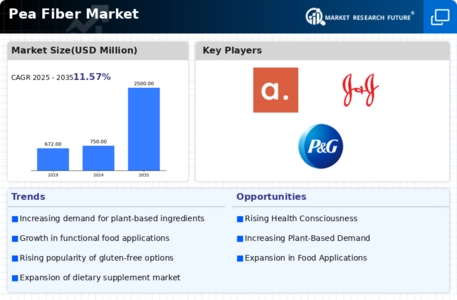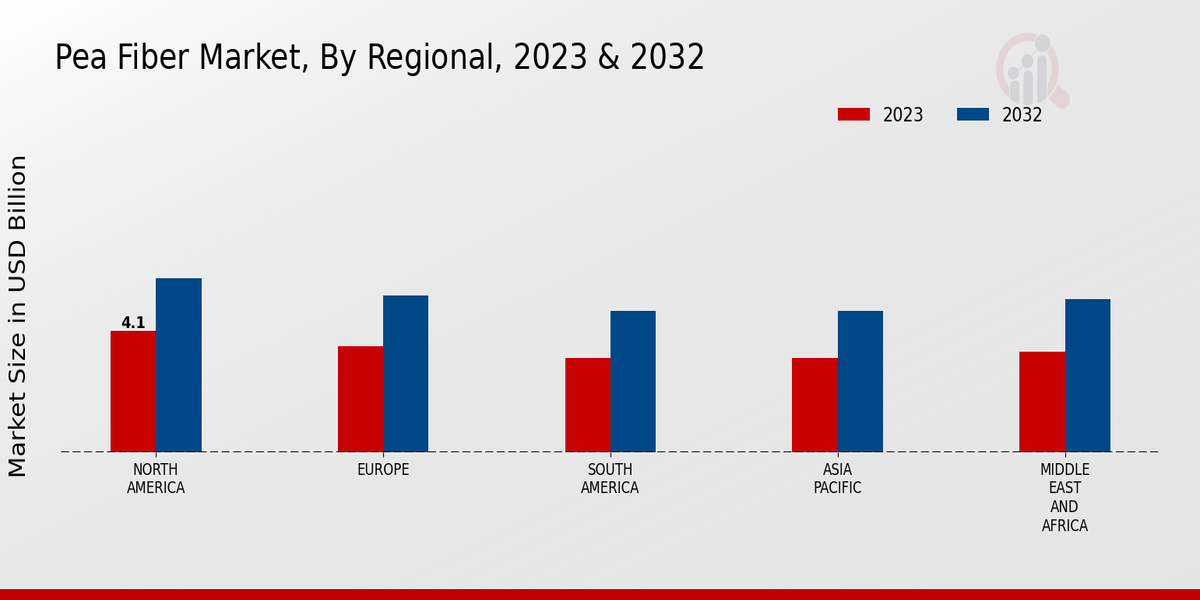Market Growth Projections
The Global Pea Fiber Market Industry is on a trajectory of significant growth, with projections indicating a market value of 750 USD Million in 2024. This growth is expected to accelerate, with forecasts suggesting that the market could reach 2500 USD Million by 2035. The compound annual growth rate (CAGR) is anticipated to be 11.57% from 2025 to 2035, reflecting the increasing adoption of pea fiber across various sectors, including food and beverages, nutraceuticals, and personal care products. This upward trend underscores the potential for pea fiber to become a staple ingredient in health-focused formulations, driven by consumer demand for nutritious and sustainable options.
Innovation in Food Products
Innovation plays a crucial role in the expansion of the Global Pea Fiber Market Industry, as manufacturers continuously develop new products that incorporate pea fiber. This innovation is evident in various sectors, including snacks, bakery items, and meat alternatives, where pea fiber enhances texture and nutritional value. For instance, several companies are launching high-fiber snacks that appeal to health-conscious consumers, thereby driving market growth. The introduction of innovative formulations utilizing pea fiber not only meets consumer demands but also aligns with the industry's projected growth trajectory, with expectations of reaching 2500 USD Million by 2035.
Health Benefits of Dietary Fiber
The Global Pea Fiber Market Industry is significantly influenced by the growing awareness of the health benefits associated with dietary fiber consumption. Research indicates that adequate fiber intake can aid in digestion, regulate blood sugar levels, and promote heart health. As consumers become increasingly health-conscious, they seek products that incorporate high-fiber ingredients, such as pea fiber, into their diets. This shift is evident in the rising popularity of functional foods and beverages enriched with pea fiber, which cater to the demand for nutritious options. Consequently, the industry is poised for substantial growth, aligning with the projected market value of 750 USD Million in 2024.
Growing Application in Nutraceuticals
The Global Pea Fiber Market Industry is witnessing an increase in the application of pea fiber within the nutraceutical sector. As consumers become more health-oriented, there is a growing interest in dietary supplements that promote overall well-being. Pea fiber, known for its digestive health benefits, is being incorporated into various nutraceutical products, catering to this demand. The rise in health supplements that utilize pea fiber is indicative of a broader trend towards functional ingredients that support health. This growing application is expected to drive market growth, with the industry projected to reach 2500 USD Million by 2035.
Rising Demand for Plant-Based Ingredients
The Global Pea Fiber Market Industry experiences a notable surge in demand for plant-based ingredients, driven by the increasing consumer preference for healthier and sustainable food options. As more individuals adopt vegetarian and vegan diets, the need for alternative sources of protein and fiber becomes paramount. Pea fiber, derived from yellow peas, offers a rich source of dietary fiber and protein, appealing to health-conscious consumers. This trend is reflected in the projected market growth, with the industry expected to reach 750 USD Million in 2024 and potentially expand to 2500 USD Million by 2035, indicating a robust compound annual growth rate of 11.57% from 2025 to 2035.
Sustainability and Environmental Concerns
Sustainability is increasingly becoming a focal point within the Global Pea Fiber Market Industry, as consumers and manufacturers alike prioritize environmentally friendly practices. Pea cultivation requires fewer resources compared to other crops, making pea fiber a sustainable ingredient choice. This aligns with the global movement towards reducing carbon footprints and promoting eco-friendly products. As consumers seek transparency in sourcing and production, the demand for sustainably sourced pea fiber is likely to rise. This trend is expected to contribute to the industry's growth, with projections indicating a market value of 750 USD Million in 2024 and a potential increase to 2500 USD Million by 2035.















Leave a Comment